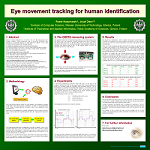Eyes are windows to our soul
William Shakespeare
Eye movements in biometrics

Eyes are one of the most complicated human organs and the analyses of eye movements may reveal a lot of information about the human being.
There are a lot of studies that analyze eye movements in order to diagnose specific diseases or to recognize state of mind [6].
However, surprisingly, there are only a few research trying to differentiate people on the basis of their eye movements characteristic.
The first publication about eye-movement biometric authentication was a poster presentation during 6th World Conference Biometrics'2003 in London by Pawel Kasprowski and Józef Ober [11].
The poster achieved the Best Poster on Technological Advance Prize what encouraged authors to further research and resulted in several publications [12][13][18]. A
Another attempt was [1]. Despite of quite complex experiments including text reading, moving point observation and image viewing, finally people were identified basing only on the way they look at static point (red cross) in the middle of the screen. Similarly to [18] the data was preprocessed using FFT and then reduced with PCA method. The authors considered four different features, from which only "velocity of gaze" was truly dynamic.
In 2006, Silver et al [26] proposed the first known combination of eye movements biometrics and keystroke dynamics. Data from both modalities were recorded during one experiment. However, results from keyboard dynamics were reported to give much lower error rates and only some limited properties of eye movements (like number of fixations and average fixation length) were used.
The following publication was [22], in which authors compared people by measuring the placement of their blind spot - what in fact used eye movements only to establish physiological properties of eyes and didn't involve usage of dynamic properties of oculomotor system.
 Two interesting research papers were published during ETRA 2010 conference. Kinnunen at al. [19] proposed a very interesting solution based on so called 'task-independent' authentication. They didn't use any special stimulation and just recorded eye movements when a subject was watching a movie. The results obtained weren't very good (error rates about 30%) but encouraging. Another work was [20]. The authors performed the experiment very similar to [18] with a jumping point stimulation. The main difference was applying so-called Oculomotor Plant Mathematical Model (OPMM) developed by authors, what improved their results.
Two interesting research papers were published during ETRA 2010 conference. Kinnunen at al. [19] proposed a very interesting solution based on so called 'task-independent' authentication. They didn't use any special stimulation and just recorded eye movements when a subject was watching a movie. The results obtained weren't very good (error rates about 30%) but encouraging. Another work was [20]. The authors performed the experiment very similar to [18] with a jumping point stimulation. The main difference was applying so-called Oculomotor Plant Mathematical Model (OPMM) developed by authors, what improved their results.
In 2011 Deravi et al [5] published a paper, in which they checked performance of human identification of people looking at the static images. However, there were only three subjects in their experiment so the results cannot be considered reliable.
Since 2010 Komogortsev, after achieving a scientific grant from National Institute of Standards and Technology (NIST), was able to publish several interesting papers, in which he tried to use his OPMM in different experiments.
One of the most interesting was the text reading experiment [7].
Recently, he has also tried to analyze the usability of the eye movement biometrics from the prospective users point of view [3].
 In 2012 Kasprowski and Komogorsev organized th first Eye Movement Verification and Identification Competition, what resulted in several publications [17][25][23]. Probably the contest announced as part of one of the most important IEEE biometric conferences influenced the popularity of eye movements biometrics, because there were several new papers published in 2012 [24][2][27][28].
In 2012 Kasprowski and Komogorsev organized th first Eye Movement Verification and Identification Competition, what resulted in several publications [17][25][23]. Probably the contest announced as part of one of the most important IEEE biometric conferences influenced the popularity of eye movements biometrics, because there were several new papers published in 2012 [24][2][27][28].
In the most original paper Biedert et al [2] analyzed eye movements of subjects during their normal activity (opening mails, reading documents). They tried to prove that it is possible to estimate whether the subject is familiar with computer desktop and that way identify the intruder (who is supposedly not familiar with it).
Another interesting publication was [24]. Authors used face observation as visual stimulus and compared different scan paths of eye movements using original graph based method. The method was later successfully used for EMVIC datasets [25].
In the aforementioned eye movements publications authors retrieved different features of an eye movements signal. In most cases the signal was preprocessed to divide it into fixations (moments when the eye is looking at one place) and saccades (rapid movements from one fixation point to another) [20][28][26][24][25]. Some authors focused on fixation information, retrieving fixation sequences [24] or eye micro-movements during fixations [1]. Other authors focused on saccades calculating their velocities and accelerations [27][28]. There were also approaches that used raw signals and different transformations [18][23].
Literature references
[1] Bednarik, R.; Kinnunen, T.; Mihaila, A.; Fränti, P.: Eye-movements as a biometric, In 14 Scandinavian Conference on Image Analysis, Lecture Notes in Computer Science, Springer-Verlag, vol. 3540, pp. 780-789, 2005.
[2] Biedert, R., Frank, M., Martinovic, I., Song, D. Stimuli for Gaze Based Intrusion Detection. In Future Information Technology, Application, and Service (pp. 757-763). Springer Netherlands 2012.
[3] Brooks, M., Aragon C.R., Komogortsev O.V.: Perceptions of Interfaces for Eye Movement Biometrics. Proc. International Conference on Biometrics. 2013.
[4] Daugman, J. G.: High confidence visual recognition of persons by a test of statistical independence. Pattern Analysis and Machine Intelligence, IEEE Transactions on, 1993.
[5] Deravi, F., Shivanand P. G.: Gaze Trajectory as a Biometric Modality. BIOSIGNALS. 2011.
[6] Duchowski A.: A Breadth-First Surveyof Eye Tracking Applications. Behavior Research Methods, Instruments & Computers (BRMIC), 34(4). 2002
[7] Holland, C., Komogortsev, O. V.: Biometric identification via eye movement scanpaths in reading. In Biometrics (IJCB), 2011 International Joint Conference on (pp. 1-8). IEEE. 2011.
[8] Henderson, John M., and Andrew Hollingworth. Eye movements during scene viewing: An overview. Eye guidance in reading and scene perception 11 (1998): 269-293.
[9] Hornof A. J., Halverson T.: Cleaning up systematic error in eye tracking data by using required fixation locations. Behavior Research Methods, Instruments, and Computers, 34(4) 2002.
[10] Jain, A.; Hong, L. et al.: Biometric identification. Communications ACM 43(2): 90-98, 2000.
[11] Kasprowski, P., Ober, J. Eye movement tracking for human identification, 6th World Conference BIOMETRICS'2003, London, 2003.
[12] Kasprowski, P., Ober, J.: With the flick of an eye. Biometric Technology Today, 2004.
[13] Kasprowski, P., Ober, J.: Enhancing eye-movement-based biometric identification method by using voting classifiers. In Defense and Security (pp. 314-323). SPIE, International Society for Optics and Photonics. 2005.
[14] Kasprowski, P.: Human identification using eye movements. Doctoral thesis. Silesian Unversity of Technology, Poland, 2004.
[15] Kasprowski, P.: The Impact of Temporal Proximity between Samples on Eye Movement Biometric Identification. Computer Information Systems and Industrial Management. LNCS 8104, Springer-Verlag, 2013.
[16] Kasprowski, P., Rigas I.: The influence of dataset quality on the results of behavioral biometric experiments. IEEE BIOSIG 2013 Conference, Lecture Notes in Informatics (LNI), Vol P-212, Bonn 2013.
[17] Kasprowski, P.; Komogortsev, O. V.; Karpov, A.: First Eye Movement Verification and Identification Competition at BTAS 2012. IEEE Fifth International Conference on Biometrics: Theory, Applications and Systems (BTAS), 2012.
[18] Kasprowski, P.; Ober. J.: Eye Movement in Biometrics, Proceedings of Biometric Authentication Workshop, European Conference on Computer Vision in Prague 2004, LNCS 3087, Springer-Verlag., 2004.
[19] Kinnunen T., Sedlak F., Bednarik R.: Towards task-independent person authentication using eye movement signals. Proceedings of the 2010 Symposium on Eye-Tracking Research & Applications, ACM New York, NY, USA 2010.
[20] Komogortsev O., Jayarathna S., Aragon C.R., Mahmoud M.: Biometric Identification via an Oculomotor Plant Mathematical Model. Proceedings of the 2010 Symposium on Eye-Tracking Research & Applications, ACM New York, NY, USA 2010.
[21] for Mathematics and Scientific Computing, National Physical Laboratory, 2002.
[22] Nishigaki, M. and Arai, D.: A user authentication based on human reflexes using blind spot and saccades response, International Journal of Biometrics, Vol. 1, No. 2, pp. 173-189, 2008.
[23] Cuong, N. V.; Dinh, V.; Ho, L. S. T.: Mel-frequency Cepstral Coefficients for Eye Movement Identification. IEEE International Conference on Tools with Artificial Intelligence (ICTAI 2012).
[24] Rigas, I.; Economou, G.; Fotopoulos, S.: Biometric identification based on the eye movements and graph matching techniques, Pattern Recognition Letters, Volume 33, Issue 6, 15 April 2012, Pages 786-792, ISSN 0167-8655, 2012.
[25] Rigas, I.; Economou, G.; Fotopoulos, S.: Human eye movements as a trait for biometrical identification. IEEE Fifth International Conference on Biometrics: Theory, Applications and Systems (BTAS), pp. 217-222, 2012.
[26] Silver, D.L., Biggs, A: Keystroke and Eye-Tracking Biometrics for User Identification. IC-AI. 2006.
[27] Zhang, Y., Juhola M.: On Biometric Verification of a User by Means of Eye Movement Data Mining. IMMM 2012, The Second International Conference on Advances in Information Mining and Management. 2012.
[28] Zhen, L., Tan F., Chi Z.: Video-based biometric identification using eye tracking technique. Signal Processing, Communication and Computing (ICSPCC), 2012 IEEE International Conference on. IEEE, 2012.
 EMVIC 2014
EMVIC 2014
 EMVIC 2014
EMVIC 2014
 Two interesting research papers were published during ETRA 2010 conference. Kinnunen at al. [19] proposed a very interesting solution based on so called 'task-independent' authentication. They didn't use any special stimulation and just recorded eye movements when a subject was watching a movie. The results obtained weren't very good (error rates about 30%) but encouraging. Another work was [20]. The authors performed the experiment very similar to [18] with a jumping point stimulation. The main difference was applying so-called Oculomotor Plant Mathematical Model (OPMM) developed by authors, what improved their results.
Two interesting research papers were published during ETRA 2010 conference. Kinnunen at al. [19] proposed a very interesting solution based on so called 'task-independent' authentication. They didn't use any special stimulation and just recorded eye movements when a subject was watching a movie. The results obtained weren't very good (error rates about 30%) but encouraging. Another work was [20]. The authors performed the experiment very similar to [18] with a jumping point stimulation. The main difference was applying so-called Oculomotor Plant Mathematical Model (OPMM) developed by authors, what improved their results.
 In 2012 Kasprowski and Komogorsev organized th first Eye Movement Verification and Identification Competition, what resulted in several publications [17][25][23]. Probably the contest announced as part of one of the most important IEEE biometric conferences influenced the popularity of eye movements biometrics, because there were several new papers published in 2012 [24][2][27][28].
In 2012 Kasprowski and Komogorsev organized th first Eye Movement Verification and Identification Competition, what resulted in several publications [17][25][23]. Probably the contest announced as part of one of the most important IEEE biometric conferences influenced the popularity of eye movements biometrics, because there were several new papers published in 2012 [24][2][27][28].